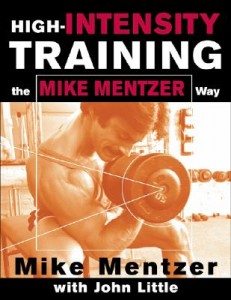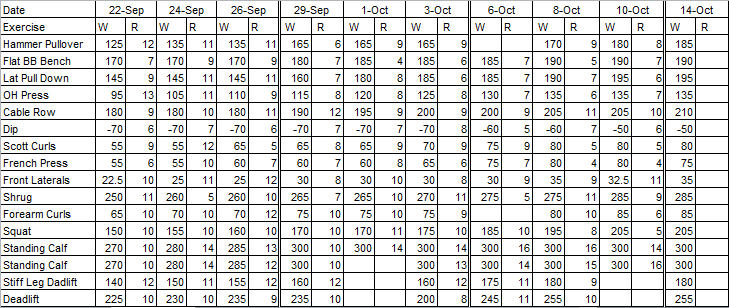 I am a big believer in full body workouts. Yes, if you want to get really huge then a body part split of some sort is going to work the best for you, but when you just want to get into great shape a full body workout is going to do the trick. When you do a full body workout you are able to play with the rest period and give yourself a cardio effect. At the same time you hit the various body parts more often and force them to change. There are some rules to full body workouts.
I am a big believer in full body workouts. Yes, if you want to get really huge then a body part split of some sort is going to work the best for you, but when you just want to get into great shape a full body workout is going to do the trick. When you do a full body workout you are able to play with the rest period and give yourself a cardio effect. At the same time you hit the various body parts more often and force them to change. There are some rules to full body workouts.
How often to train
Full body workouts should be done on a 3 day a week schedule, every other day with two days off after the last workout before starting the next week. I suggest working out Monday, Wednesday and Friday. Take Saturday and Sunday off completely.
Recovery issues
Pay attention to the numbers on the exercises you are doing. If you begin to struggle then cut a day out of the schedule. That's right, I said cut down to 2 days a week. With a full body workout you will still get good results. I have gone through this before and it really does continue to work well. Just keep a close eye on recovery.
HIT Style – Wikipedia
Wikipedia tells us about HIT (High Intensity Training):
“High Intensity Training (HIT) is a form of strength training popularized in the 1970s by Arthur Jones, the founder of nautilus. The training focuses on performing quality weight training repetitions to the point of momentary muscular failure. The training takes into account the number of repetitions, the amount of weight, and the amount of time the muscle is exposed to tension in order to maximize the amount of muscle fiber recruitment.
The fundamental principles of High Intensity Training (HIT) are that exercise should be brief, infrequent, and intense. Exercises are performed with a high level of effort, or intensity, where it is thought that it will stimulate the body to produce an increase in muscular strength and size. Advocates of HIT believe that this method is superior for strength and size building to most other methods which, for example, may stress lower weights with larger volume (sets x reps).
As strength increases, HIT techniques will have the weight/resistance increased progressively where it is thought that it will provide the muscles with adequate overload to stimulate further improvements. There is an inverse relationship between how intensely and how long one can exercise. As a result, high intensity workouts are generally kept brief. After a High Intensity workout, as with any workout, the body requires time to recover and produce the responses stimulated during the workout, so there is more emphasis on rest and recovery in the HIT philosophy than in most other weight training methods. In any workout, not just HIT, training schedules should allow adequate time between workouts for recovery (and adaptation).While many typical HIT programs comprise a single-set per exercise, tri-weekly, full-body workout, many variations exist in specific recommendations of set and exercise number, workout routines, volume and frequency of training. The common thread is an emphasis on a high level of effort, relatively brief and infrequent (i.e. not daily) training, and the cadence of a lift, which will be very slow compared to a non-HIT weight training routine.
Most HIT advocates stress the use of controlled lifting speeds and strict form, with special attention paid to avoiding any bouncing, jerking, or yanking of the weight or machine movement arm during exercise. Technical HIT advice varies from lifting the weights smoothly and at a natural pace, to timing the lifts, peaking at hold and descent. In extreme cases, it may take up to 30 seconds to complete a single repetition. While high intensity training is strongly associated with Nautilus exercise equipment, advocates vary in their equipment recommendations.
Also emphasized when near exhaustion in order to further exhaust the muscle or muscles exercised: doing static holds for periods of time, and negative reps (lowering the weight). This will stimulate further growth and strength because muscles are weakest in positive/contracting movements (sometimes referred to as first stage failure of a muscle). Although you may not be able to lift a weight for another rep you will almost certainly be able to hold it statically for a further period (second stage of failure) and finally lower a weight at a slow controlled speed (third stage of failure). Until all three (lifting, holding and lowering) parts of an exercise can no longer be completed in a controlled manner a muscle cannot be considered thoroughly exhausted/exercised.”
HIT Style – Fitness Expose
I truly believe in the HIT style of training and I use it on many of my clients who are looking to lose fat and get in better shape. Not everyone wants to be a bodybuilder and this style of training gets it done. In the workout today you will do one warm up set per body part and one working set to failure per exercise. That's it.
The Workout
| Exercise | Sets | Reps |
| Hammer Pull over* | 1 | 10-12 |
| Flat BB Bench Press* | 1 | 8-10 |
| Lat pull down | 1 | 10-12 |
| OH Press* | 1 | 8-10 |
| Cable row | 1 | 10-12 |
| Dip | 1 | 8-10 |
| Scott Curls* | 1 | 10-12 |
| French Press* | 1 | 8-10 |
| Front Laterals | 1 | 10-12 |
| Shrug | 1 | 10-12 |
| Squat* | 1 | 10-12 |
| Standing Calf | 1 | 12-15 |
| Standing Calf | 1 | 12-15 |
| Stiff Legged Deadlift | 1 | 12-15 |
| Deadlift | 1 | 8-10 |
* indicates the point where you will do a warm up set. It exists at the first exercise for each body part.
Execution of the Workout
You will note that there is a single set of each exercise. You will also note there is a repetition range. You will be taking these single sets to complete failure. When picking a weight you will aim for a weight that will bring you to failure at the bottom part of the repetition range. Each time you train you wll try to get at least one more repetition before failing. When you can exceed the top range of the repetition range you will add weight on the next training session and start over again. This will force a natural progression to your workout.
My Explanation of the Workout
I used this exact workout for a 4 week period in 2010. Below is an actual screen capture of my training spreadsheet from that period. You will note the tremendous increase in the weight during that time period.

Notice that all weights increased during this time period.
Give this full body workout a spin. You will see major gains in your strength and major changes in your body. To learn more about High Intensity Training get the Mike Mentzer book pictured above.
